Mark Sisson's Blog, page 62
September 23, 2020
Type I, II, or III Collagen? Different types of Collagen and How to Choose the Best One for You
 When a person goes looking for information on “collagen” supplements, they often come out more confused than they went in. There are seemingly dozens of different varieties. There’s gelatin. There’s animal collagen. There’s marine collagen. Hydrolysate and peptides. And then there are all the “types” of collagen: type I, type II, type III, type IV, type V, and on down the line, each with unique properties and applications. Everyone seems to say something different.
When a person goes looking for information on “collagen” supplements, they often come out more confused than they went in. There are seemingly dozens of different varieties. There’s gelatin. There’s animal collagen. There’s marine collagen. Hydrolysate and peptides. And then there are all the “types” of collagen: type I, type II, type III, type IV, type V, and on down the line, each with unique properties and applications. Everyone seems to say something different.
What are you supposed to believe? How does a person make sense of it all? What are differences between them?
Let’s do that right now.
Gelatin
Gelatin is heat-treated collagenous animal tissue. Whether you’re a food manufacturer turning raw skin and bones into powdered gelatin for use in jello or a home cook slowly simmering beef knuckles in a pot on the stove to make rich bone broth that gelatinizes when cold, you are using heat to convert collagenous tissue into gelatin.
Gelatin is partially soluble in water. While its chemical structure prevents it from dissolving in cold or room temperature water, it does dissolve in hot water.
The health benefits of gelatin are equal to collagen. They have the same amino acid profile — lots of glycine, proline, hydroxyproline, alanine, lysine, and others. Inside the body, they’re all broken down into those same amino acids and utilized.
Gelatin is fantastic to have in the kitchen. While you can’t just mix it into cold drinks or throw it in a smoothie like you can collagen hydrolysate, you can use it to thicken pan sauces, enrich store bought stock and broth, and make healthy jello treats or luxurious gelatinous desserts.
Whenever I make a curry with coconut milk, as one of the final steps I whisk in a tablespoon or two of gelatin to thicken it up and give the curry that syrupy mouth feel. This is a game-changer, folks. Try it and you’ll see. This is also works in spaghetti sauce, soup, pretty much anything that includes liquid. Frying up a burger? Add some water to the pan, scrape up the fond (brown bits attached to the pan that are full of flavor), whisk in some gelatin, and reduce until it’s a thick sauce.
Instantly download your Guide to a Healthy Gut
Collagen Hydrolysate and Peptides
Collagen hydrolysate and peptides both mix readily into hot and cold liquids, and they give your body what it needs to assemble its own collagen. Hydrolysis is the process, peptides are the end product. Collagen hydrolysate refers to the process of using enzymes to break the peptide bonds to produce collagen peptides.
Animal Collagen
All collagen you see is animal collagen because there is no collagen that comes from non-animal sources. Plants do not contain collagen. I’m sure some startup is hard at work on producing lab-grown collagen, which ironically might be far less problematic than lab-grown steaks, but it isn’t available for purchase yet. It’s all animals.
What most people mean by “animal collagen” is land animal collagen—by far the most common type. Unless explicitly stated otherwise, the collagen you encounter on the market comes from land animals like cows and pigs.
Animal collagen is the most evolutionarily congruent type on the planet. Because for as long as we’ve been eating animals (well over a million years), we’ve been stripping them of their collagenous tissue for consumption. Even when the collagen wasn’t visible but rather entombed in weight-bearing bones, we would smash those bones with stones and boil them in ruminant stomachs to extract every last drop of fat and collagen.1
Don’t worry about any negative things you might hear about “animal collagen”; it’s what we’re made to eat. Heck, it’s what we’re made of.
Marine Collagen
Marine collagen is not extra-strong collagen derived from the battle-hardened sinews and bones of fallen heroes from the US Marine Corps. It is collagen derived from marine animals, usually fish but also invertebrates like squid, cuttlefish, and jellyfish.
Marketing types selling fish collagen claim that due to its lower molecular weight, marine collagen will be more bioavailable than collagen from land animals. This could be true. Fish collagen drawn from fish waste does have lower molecular weight than mammalian collagen, and that should lead to slightly higher bioavailability.2 But I wonder of its relevance.
One pro-marine collagen paper that makes a strong case for the use of marine collagen in wound repair, oral supplementation, and other medical applications does not mention increased bioavailability. It may be slightly more bioavailable—the lower the molecular weight, the more true that is—but I don’t think the effect is very meaningful. We know mammalian collagen is plenty bioavailable because most studies use collagen from cows or pigs, even if it’s a few dozen kilodaltons heavier.
Collagen Quench: a refreshing way to get your collagen
Collagen Types I, II, III, IV, and V
Collagenous tissues are not uniform. Cartilage doesn’t look or feel like tendon, which doesn’t feel like skin. They’re all slightly different because there are different “types” of collagen that constitute them. Over two dozen, actually. But if we’re talking about supplementary or dietary collagen, there are three primary types we encounter.
Type I Collagen
Found in skin, bones, tendons, eyes, and many other tissues type I collagen constitutes almost 90% of the collagen in the body. That goes for humans but also cows and pigs and other mammals, meaning throughout the course of meat-eating human history, the vast majority of dietary collagen we’ve consumed has been type I collagen. As such, type I, though “boring and unexciting,” is the form of collagen we should be focusing on.
Type II Collagen
Cartilage is made of type II collagen. If you’re a gristle eater, an end-of-bone scraper, you’re getting type II collagen. You can also get a nice dose of type II collagen by eating the sternum of the chicken carcass—that’s the unctuous morsel of chewy cartilage lying at the end of the chest bone between the ribcages and one of my favorite parts of the chicken.
Type III Collagen
Type III collagen appears alongside type I in skin, bones, and also can be found in blood vessels and other hollow organs throughout the body. Most collagen supplements are type I with a bit of type III.
Types IV and V
Types IV and V aren’t as abundant in the body, and aren’t as widely used in supplements. You may see these in supplements as part of combination collagens. If you eat a varied diet, you’ll probably get enough in your food.
Focus on Types I, II, and III for skin, hair, joints, and other benefits you’re after. How much of each? To be quite honest, it’s not a big deal either way if you get more Type I than Type II or Type III. They’re all made up of the same basic amino acids, and your body knows what to do with them once they’re digested and assimilated. You don’t need to micromanage various collagen types as long as you’re eating some form of the collagen, whether through collagen peptides, gelatin, or gelatinous meats and bones.
I wish it were different. I wish you could get crazily specific effects by eating a lot of a specific collagen type. But, as far as my research shows, you can’t.
Thanks for reading, everyone. I hope it clears some things up and makes your decision a whole lot easier.
References https://trace.tennessee.edu/cgi/viewcontent.cgi?referer=https://www.bing.com/&httpsredir=1&article=1544&context=utk_gradtheshttps://www.ncbi.nlm.nih.gov/pmc/articles/PMC4486571/
The post Type I, II, or III Collagen? Different types of Collagen and How to Choose the Best One for You appeared first on Mark's Daily Apple.



September 22, 2020
Parental Burnout: What to Do If You Feel Overwhelmed as a Parent
 Last year, an article in the New York Times described “The Relentlessness of Modern Parenting.” That word struck me at the time and has stuck with me ever since. Speaking as a mom of two, the expectations and pressures weighing on parents can indeed feel relentless.
Last year, an article in the New York Times described “The Relentlessness of Modern Parenting.” That word struck me at the time and has stuck with me ever since. Speaking as a mom of two, the expectations and pressures weighing on parents can indeed feel relentless.
It’s not enough to keep our children clothed and fed, get them to school, and take the occasional family vacation. Parents today should provide optimal nutrition from birth and ensure that kids have the best educational opportunities. We’re told to enroll them in sports, extracurriculars, and tutoring to give them a competitive edge for college, then we’re obliged to volunteer as assistant coach, snack mom, and classroom parent. By the way, you’re already saving money for college, right?
Don’t forget, we’re also in charge of arranging playdates, monitoring screen time, and searching Pinterest for unique birthday party ideas and fun hijinks for the Elf on the Shelf.
No wonder parents are succumbing to burnout.
Stay on track no matter where you are! Instantly download your Primal and Keto Guide to Eating Out
What is Parental Burnout?
For academics, the term parental burnout has a specific meaning. In 2018, Belgian researchers developed the Parental Burnout Assessment, which comprises four factors:1
Exhaustion, e.g., “I feel completely run down by my role as a parent.”
Contrast with previous parental self, e.g., “I don’t think I’m the good father/mother that I used to be to my child(ren).”
Feeling fed up, e.g., “I feel like I can’t take any more as a parent.”
Emotional distancing from one’s children, e.g., “I’m no longer able to show my child(ren) how much I love them.”
By this definition, burnout is more than just stress, worry, or fatigue, which all parents experience sometimes. It’s a deep, deep weariness that drains your ability to parent effectively, leaving you empty and unable to connect to your kids. Left unchecked, it can lead to parental neglect and violence. Burnout also correlates with depression, sleep disturbances, and addictive behaviors, though it’s unclear if burnout causes those issues or vice versa.2
Melt your stress away with Adaptogenic Calm
Risk Factors for Parental Burnout
Some of the factors that make a parent more vulnerable to burnout are:
Holding themselves to unrealistic standards
Difficult family situations due to socioeconomic pressures, strain with co-parents, or children with special health or developmental challenges, for example
Not wanting to be a parent in the first place
Lack of social support, not having a “village”
Personality traits like neuroticism, general lack of coping skills
Is Parental Burnout an Especially Modern Phenomenon?
Since research into parental burnout is fairly new, there’s no longitudinal data that speaks directly to this. Intuitively, though, it feels like parents today must experience more burnout than previous generations.
Parenting is continually evolving. Both mothers and fathers spend considerably more time interacting with their kids than they did 50 years ago.3 We’re overscheduled and overcommitted, which means we’re overstressed.4 The financial cost of raising a child continues to rise. Social media presents a host of new challenges—cyberbullying, mommy wars, and FOMO, oh my!
More to the point, parents face social pressure to be constantly “on” like never before. Sociologists refer to this as intensive parenting, so named by Sharon Hays in her 1996 book The Cultural Contradictions of Motherhood. Parents, especially mothers, are expected to invest heavily in their children, devoting nearly unlimited time, emotional energy, and money to parenting. Intensive parenting holds that parents are responsible for managing every aspect of kids’ lives, preventing all manner of potential harm, and ensuring the best possible outcomes for their children.
Clearly, these standards are unattainable for many—perhaps most—parents. In particular, wealth heavily impacts the types of opportunities parents can access for their kids and the amount of time they can devote to parenting. Yet parents across the spectrum endorse intensive parenting ideals.5
The pressure to live up to the ideal is intense, and it’s both external and internal. A study of 1725 Finnish parents, mostly mothers, revealed that the biggest risk factor for burnout was “socially prescribed perfectionism,” especially when coupled with self-expectations of perfectionism.6 Not surprisingly, intensive parenting beliefs are associated with greater stress, depression, anxiety, and guilt for mothers.7
How Common Is Parental Burnout?
It’s hard to know how many parents experience burnout according to the academic criteria described above. Studies suggest it’s anywhere from 1 percent to 20 percent, depending on where the study is done.8 9 10 That doesn’t take into account extenuating circumstances such as having a child with chronic illness, which is known to increase parental stress.11
You might not reach the official threshold for Parental Burnout with a capital P-B. Still, most of my fellow parents can probably relate to sometimes—or often—feeling exhausted, like you have nothing left to offer at the end of the day. A March 2020 survey asked more than 3,000 American moms, “In the past month, how often have you felt ‘burned out’ by motherhood?” Thirty-five percent of respondents said they frequently do, while 6 percent said always.
That’s a lot. Only 14 percent said they rarely or never feel this way. That doesn’t mean these moms don’t find parenting to be rewarding and enjoyable overall, but it reinforces just how demanding modern parenting is.
What about Fathers, Can’t They Experience Burnout?
Definitely. However, parenting and burnout research focuses mainly on mothers. On average, mothers spend more time than fathers on parenting activities, and by and large, mothers bear the brunt of societal and self-imposed pressure to live up to ideals of parenting perfection.12 13
Of course, there are standards for fathers, too, and those standards continue to rise. Fathers who feel overwhelmed by them, or who expect too much of themselves, can absolutely succumb to burnout. According to a 2015 Pew Research Center study, equal numbers of mothers and fathers said that parenting is extremely or very important to their sense of identity, but working fathers are especially likely to feel that they don’t spend enough time with their kids.14 At least one study found that mothers and fathers experience parental burnout at the same rate.15 Another study published earlier this year found that while mothers were more likely to experience burnout, the consequences were more severe for burned out fathers.16
Are Primal Parents Especially at Risk?
I’ve been going back and forth on this. On the one hand, isolation and lack of social support are huge risk factors for burnout, and parenting outside the norm can feel lonely. Repeatedly explaining—and defending—your choices to family members, pediatricians, teachers, and fellow parents can be exhausting, especially when they challenge you and call your parenting into question.
On the other hand, Primal parents may be more comfortable with the idea of free-range parenting—exempting ourselves from the pressures of intensive parenting and opting instead for a more relaxed, less “helicopter-y” style. For these parents, I’d expect burnout to be considerably lower.
Pandemic Burnout
Not to ignore the elephant in the room, parenting through a pandemic takes the notion of parental burnout to a whole other level. It’s terribly hard to rely on our villages while adhering to social distancing guidelines. The stress of trying to keep everyone safe, working from home, and carving out time for ourselves can become overwhelming.
Ironically, though, the pandemic and lockdowns probably alleviated burnout for some parents. We’ve been forced—or rather, given the opportunity—to slow down and spend more time with our kids. In a survey conducted by the American Psychological Association at the end of May, 82 percent of parents said they were grateful for this extra time.17
Coping with Parental Burnout
In case it’s not perfectly clear, you can feel burned out without experiencing “parental burnout” in the academic sense. Whether or not you hit that threshold, which is admittedly a bit murky, the following practices are worthwhile.
Focus on the positive
It’s easy to get sucked into a negativity spiral when you’re feeling overwhelmed and anxious. Plus, self-deprecation is the norm nowadays. We’re much more likely to say, “I’m a hot mess, send wine,” than “I did some A+ parenting today and am feeling great about my kids.” That’s no good for parents already on the verge of burnout.
Experts recommend taking the time each day to focus on what went right. This might mean going around the dinner table and each naming something that made you happy, or writing a simple gratitude statement in your journal each night. Even on the worst days, it’s usually possible to find one small ray of sunshine.
The usual self-care stuff
Taking a bath or getting regular exercise isn’t a cure-all for burnout, but it can’t hurt. All of us parents should be taking the time to fill our own buckets whenever possible.
Lower your expectations
This is a big one: actively reject the intensive parenting ideal. Remind yourself it’s ok if the laundry isn’t done, your kid is five minutes late to soccer practice, you forgot to brush their hair on school picture day, and the Tooth Fairy failed to pick up the tooth last night.
This is not an overnight process, but it helps to realize that a lot of burnout stems from buying into societal standards—standards that you don’t have to live up to to be a kind and loving parent.
Here’s the real kicker: It’s not even clear that putting ourselves through all this stress pays off in terms of having happier or more successful children.18 So, how about we all try to stop holding ourselves, and each other, to unrealistic standards that make us miserable, okay?
Stop parenting on social media
Another big one. Don’t spend valuable time and energy curating a parenting facade on social media. More importantly, stop following people who make you feel “less than” in comparison. You don’t need to compete with other parents to see whose kid is having the most magical childhood. Keep your eyes on your own paper.
Get help
You deserve to feel good about yourself as a parent, period. If you don’t, whether it’s because you are overwhelmed or need help developing effective parenting tools, don’t wait until you’re totally underwater. Ask for help now.
Burnout isn’t an inevitable consequence of modern parenting. Many parents shield themselves from the weight of the expectations and find everyday joy in raising their small humans. It’s not easy… but nothing about parenting is, is it?
I usually end by asking for feedback, but today I’d just like to offer a virtual high-five, fist bump, or hug to my fellow parents out there. Parenting is tough, but you’re tougher! You’ve got this.
References https://www.ncbi.nlm.nih.gov/pmc/articles/PMC5998056/https://journals.sagepub.com/doi/abs/10.1177/2167702619858430https://www.economist.com/graphic-detail/2017/11/27/parents-now-spend-twice-as-much-time-with-their-children-as-50-years-agohttps://www.pewsocialtrends.org/2015/12/17/parenting-in-america/https://academic.oup.com/sf/article-abstract/98/1/31/5257458https://link.springer.com/article/10.1007%2Fs10826-019-01607-1https://link.springer.com/article/10.1007%2Fs10826-012-9615-zhttps://www.ncbi.nlm.nih.gov/pmc/articles/PMC5298986/https://www.ncbi.nlm.nih.gov/pmc/articles/PMC5974116/https://www.ncbi.nlm.nih.gov/pmc/articles/PMC6019475/https://www.ncbi.nlm.nih.gov/pubmed/19912139https://link.springer.com/chapter/10.1057/9781137304612_2https://pubmed.ncbi.nlm.nih.gov/24635763/https://www.pewsocialtrends.org/2015/12/17/parenting-in-america/https://www.ncbi.nlm.nih.gov/pmc/articles/PMC5298986/https://link.springer.com/article/10.1007/s11199-020-01121-5https://www.apa.org/news/press/releases/stress/2020/stress-in-america-covid-june.pdfhttps://psycnet.apa.org/record/2014-35159-001
The post Parental Burnout: What to Do If You Feel Overwhelmed as a Parent appeared first on Mark's Daily Apple.



September 21, 2020
Beyond Pumpkin Spice: The Benefits of Cinnamon for Blood Sugar, Infections, and More
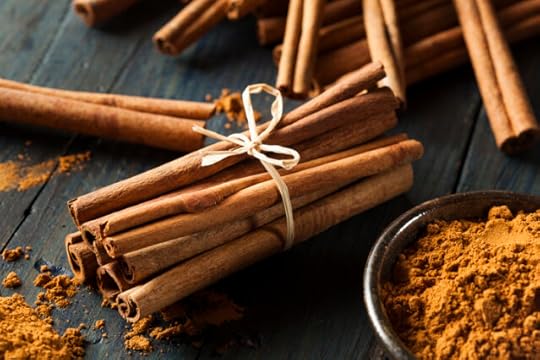 As soon as the sun sets on the last day of summer, the world seems to explode with warm fall spices. We start to see cinnamon candles, baked goods, and bundles of cinnamon sticks as decor. While pumpkin spice takes center stage, it’s not actually the pumpkin you’re after – it’s the cinnamon with other warm spices that make your chilly nights extra cozy. You may think of it as a flavor enhancer, but the health benefits of cinnamon are worth a second look,.
As soon as the sun sets on the last day of summer, the world seems to explode with warm fall spices. We start to see cinnamon candles, baked goods, and bundles of cinnamon sticks as decor. While pumpkin spice takes center stage, it’s not actually the pumpkin you’re after – it’s the cinnamon with other warm spices that make your chilly nights extra cozy. You may think of it as a flavor enhancer, but the health benefits of cinnamon are worth a second look,.
For most of human history, spices like cinnamon were also prized for their medicinal qualities. Turmeric was used in food and to address digestive disorders and inflammation. Chili peppers were used for pain management. Ancient healers reached for ginger for nausea and diarrhea.
These aren’t just exaggerated cases of “folk medicine” or “old wives’ tales,” either. Current research has confirmed that many common spices do indeed have medicinal properties. Cinnamon, one of the most beneficial spices is also found in nearly everyone’s kitchen.
Instantly download the Keto Reset Diet Recipe Sampler
Different Types of Cinnamon
It’s important to realize that there are multiple varieties of cinnamon.
Ceylon cinnamon, or “true cinnamon,” or cinnamomum zeylanicum. Ceylon cinnamon comes from the crumbly inner bark of the cinnamomum zeylanicum tree, and its flavor is sweet and delicate. It is light brown. You should be able to snap a stick of real cinnamon in half quite easily. If you’ve ever had old school cinnamon candies, that’s real Ceylon you’re tasting.
Cassia, or cinnamomum aromaticum. Cassia is usually sold as cinnamon in the United States. Recipes calling for cinnamon can use cassia instead without issue, but cassia has a harsher, more overpowering flavor with less sweetness and more brute force. It is a darker, redder brown. Cassia sticks are rather hardy and woody. Cassia is cheaper to produce and cheaper to buy than ceylon.
Saigon cinnamon, or cinnamomum loureiroi. Saigon cinnamon is the most prized member of the Cassia family. It has a full, complex flavor with even less sweetness. Saigon cinnamon is generally pretty expensive.
Which Type of Cinnamon Is Best?
As for the purported health benefits of cinnamon consumption, you’d think that “true cinnamon” is best. I mean, it’s the real stuff, right? A quick look across the web seems to confirm that suspicion, with most references you’ll find on message boards and herbal medicine sites imploring you to “get real Ceylon cinnamon, not that Cassia stuff.” But what’s the reality? Does “true” necessarily indicate “better”?
Well, let’s look at the possible benefits of cinnamon consumption, as well as the chemical component that appears to be responsible. Most researchers have focused on cinnamaldehyde, the organic compound that gives cinnamon its signature flavor. Hold on to your seat. We’re about to get a little technical.
Read next:
10 Autumn Breakfasts to Warm Your Morning
Ceylon vs. Cassia Cinnamon: Health Benefits and Risks, According to Science
Here are a few health benefits of cinnamon that are backed by research.
Oral health. Rather than merely mask a person’s bad breath, cinnamaldehyde in cinnamon-flavored chewing gum actually exerts an antimicrobial effect on the tongue bacteria that cause bad breath.1
Skin cancer. In human melanomas grafted onto mice, orally-administered cinnamaldehyde impaired cancer cell proliferation, invasiveness, and tumor growth.2
Colon cancer. Cinnamaldehyde, by (derived from Cassia bark, in fact) activating a protective antioxidant effect in human epithelial colon cells, evinced potential chemoprevention against colon cancer.3
Insect control. Cinnamon oil, most of which is cinnamaldehyde, is an effective insect repellant with the ability to specifically target and kill mosquito larvae.4
Heart health and blood sugar markers. Cinnamaldehyde was shown to decrease HbA1c, total cholesterol, and triglyceride levels while increasing plasma insulin, hepatic glycogen, and HDL levels. The oral dosage used – 20mg/kg body weight – wasn’t an unrealistic amount.5
Blood glucose. Cassia may help relieve the muscular insulin resistance that occurs following a bad night’s sleep.6
Diabetes. In another study, researchers using both Cassia extract and Ceylon extract found that the Cassia was more effective in diabetic rats observed in a glucose tolerance test.7
Parasites. Remember c. elegans, those plucky roundworms whose lifespan increased with both intermittent fasting8 and glucose restriction (the glucose study’s author, Cynthia Kenyon, has even adopted a low-carb diet in light of the results),9 and which have been deemed suitable models for the study of glucose restriction in higher mammals.10 Cassia bark had a similar effect on them, too.11
Kidneys. One study showed that cinnamon oil extracted from Ceylon bark reduced early stage diabetic nephropathy, or kidney disease.12 This particular oil was high (98% by volume) in cinnamaldehyde.
Cognitive decline. An aqueous solution of Ceylon cinnamon bark inhibited two common hallmarks of Alzheimer’s disease: tau aggregation and filament formation. Researchers isolated an A-linked proanthocyanidin (a type of polyphenol) and determined it handled the lion’s share of tau aggregation inhibition, with cinnamaldehyde possibly responsible for a fraction of it. Of the cinnamon varieties, only Ceylon carries the proanthocyanidin.13
Insulin. Another Ceylon isolate, a proanthocyanidin called proanthocyanidin B1, was shown to mimic – and even surpass – the effect of insulin in certain fat tissues.14 This particular proanthocyanidin only occurs in three places: Ceylon cinnamon bark, cat’s claw root, and the leaf of the common grape vine.
There have been mixed views on cinnamon’s efficacy in diabetic patients. One study found little overall average difference between lab results in type 2 diabetic patients given either 1.5g/d Cassia powder or placebo, although the Cassia patients enjoyed slightly larger drops in HbA1c with some experiencing more drastic reductions. The study’s authors didn’t find it statistically significant, but the results may suggest that certain individuals may be especially responsive to Cassia and Ceylon. At any rate, it’s worth trying, because people are not statistics, and the average/mean isn’t everything. Some people improved markedly, even though statistical analysis showed little difference. Any benefits in glucose tolerance and insulin sensitivity, another study noted, are also short-lived, making steady intake necessary for lasting effects.
Cinnamon Risks and Side Effects
Cinnamon side effects may include:
Mouth sores (if you’re allergic to it)15
DNA damage16
Increased risk of certain cancers17
Hypoglycemia, if your blood sugar is already on the low side18
Irritated airways if you accidentally inhale some while eating19
Coumarin in Cinnamon
Note that Cassia contains significant amounts of coumarin, which humans metabolize to 7-hydroxycoumarin, a toxin that damages the liver20 and kidneys in high amounts. Rodents metabolize it to 3,4-coumarin epoxide, a highly toxic compound, making coumarin a common ingredient in rodenticides.
A teaspoon of Cassia cinnamon powder contains 5.8 to 12.1 mg of coumarin and, according to the European Food Safety Authority, the tolerable daily intake for humans is 0.1mg/kg body weight, meaning a daily teaspoon might exceed the limit for smaller individuals.21 The German Federal Institute for Risk Assessment has gone on record in cautioning against high daily intakes of coumarin.22
In the end and for all their differences, Ceylon and Cassia are actually pretty similar (similar enough to pass for each other, for one!). They both have potent pharmacological benefits, and they’re both delicious in curries, coconut milk, coffee, and – my personal favorite when I eat them – on sweet potatoes or yams. If it’s cinnamaldehyde you’re after, the general rule is that the sweeter the cinnamon, the more concentrated the cinnamaldehyde (although ultra-concentrated doses grow more pungent). There are valid concerns with the amount of coumarin in Cassia, making daily usage of therapeutic doses questionable. Ceylon contains negligible amounts of coumarin, but its blood glucose benefits don’t seem to be as potent as Cassia’s. In my opinion, using both while never straying too far over 1 teaspoon of Cassia per day (larger individuals can go higher) is a good, safe bet.
One possible way to avoid coumarin and still eat Cassia is to make hot tea. From what I could gather online, coumarin is fat-soluble only, meaning steeping Cassia in hot water, broth (fat skimmed), or tea could extract the beneficial compounds and leave out the coumarin. Just strain the solids and drink. It may also be that traditional usage of cinnamon utilized the whole bark form, rather than the powder. Folks may not have been actually consuming the cinnamon solids, but it’s difficult to know. I assume steeping a big piece of Cassia in a pot of curry or other fatty stew would extract plenty of coumarin, provided it’s indeed fat-soluble. Either way, it’s not going to kill you unless you’re consuming heaps and heaps of Cassia powder. I suppose if you’re really worried about it, you could try one of the commercial cinnamon water-extractions on the market, but I’m usually a fan of food-based “supplementation” as long as the supplement in question exists in appreciable amounts in whole food – which they certainly do in this case.
Ah, what to use, how to extract it, and how much to consume? – the eternal question facing us students of health and optimal nutrition. Just eat, steep, grind, or cook with it, and you’ll be fine.
References http://www.sciencedaily.com/releases/2004/04/040401080031.htmhttp://www.ncbi.nlm.nih.gov/pmc/articles/PMC2650023/?tool=pmcentrezhttp://www.mdpi.com/1420-3049/15/http://www.sciencedaily.com/releases/2004/07/040716081706.htmhttp://www.ncbi.nlm.nih.gov/pubmed/17140783http://www.ncbi.nlm.nih.gov/pubmed/19627193?dopt=Citationhttp://www.ncbi.nlm.nih.gov/sites/entrez?db=pubmed&uid=15934022&cmd=showdetailview&indexed=googlehttp://www.nature.com/nature/journal/v457/n7230/full/nature07583.htmlhttp://www.sciencedaily.com/releases/2009/11/091103121605.htmhttp://diabetes.diabetesjournals.org/content/58/11/2450.fullhttp://www.ncbi.nlm.nih.gov/pubmed/20179756?dopt=Citationhttp://www.ncbi.nlm.nih.gov/pubmed/19876811?dopt=Citationhttp://www.ncbi.nlm.nih.gov/pubmed/19433898?dopt=Citationhttp://eprints.utm.my/3661/1/JTJun44F%5B5%5D_FADZILAH_ADIBAH.pdfhttps://pubmed.ncbi.nlm.nih.gov/3164031/https://efsa.onlinelibrary.wiley.com/doi/epdf/10.2903/j.efsa.2004.104https://pubmed.ncbi.nlm.nih.gov/20024932/https://pubmed.ncbi.nlm.nih.gov/25282009/https://pubchem.ncbi.nlm.nih.gov/compound/cinnamaldehydehttps://pubchem.ncbi.nlm.nih.gov/compound/coumarin#section=Metabolism-Metaboliteshttps://pubmed.ncbi.nlm.nih.gov/20024932/http://www.bfr.bund.de/cm/245/high_daily_intakes_of_cinnamon_health_risk_cannot_be_ruled_out.pdf
The post Beyond Pumpkin Spice: The Benefits of Cinnamon for Blood Sugar, Infections, and More appeared first on Mark's Daily Apple.



September 19, 2020
5 Bento Box Lunch Ideas for Adults with Recipes
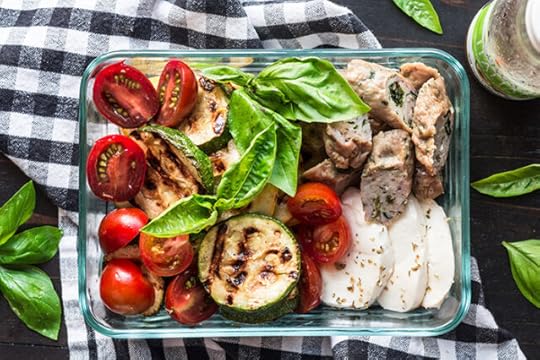 When was the last time you made yourself a nice lunch for a work day? If you’re like most people, lunch is a bit of a scramble. That’s why we came up with 5 bento box lunch ideas for adults, so you can take a breather in the middle of the day with a meal that’s enjoyable and satisfying.
When was the last time you made yourself a nice lunch for a work day? If you’re like most people, lunch is a bit of a scramble. That’s why we came up with 5 bento box lunch ideas for adults, so you can take a breather in the middle of the day with a meal that’s enjoyable and satisfying.
We hear it a lot here at Mark’s Daily Apple: Breakfast is easy, and I make dinner for my family so that’s automatic. But lunch? Most days, I just wing it. I’ll skip it sometimes just because my day is underway, or I’ll eat something that’s quick – which isn’t always the best choice.
Sound familiar?
We hear you. Making yourself a nice meal smack in the middle of the day just isn’t tenable for most people.
Prep for lunches doesn’t have to be an elaborate chore thanks to these adult lunch options. Perfect for on-the-go, these lunches utilize leftovers, basic ingredients, and quick-cooking items. When paired together, they create the perfect balanced Primal lunch.
The best part? Most of these options can be made ahead and enjoyed throughout the week.
Easy Italian Bento Lunch
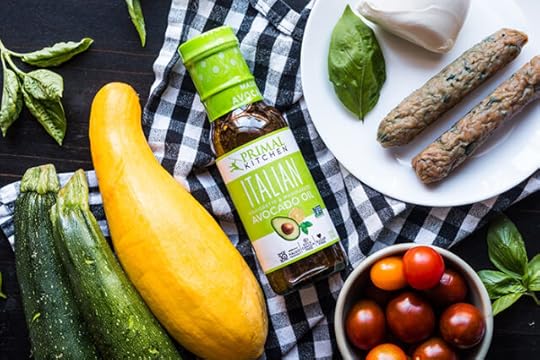
Ingredients
Sausage of choice
Mozzarella
Roasted squash
Italian dressing
Cherry tomatoes
Basil
Roast and slice your favorite sausage, using a little avocado oil spray (optional) to prevent sticking. Slice up roasted zucchini and summer squash (or your favorite veggies), toss them in Italian dressing and roast on a sheet pan until golden. Assemble your lunch with the sliced sausages, mozzarella, the roasted squash, sliced tomatoes and garnish with fresh basil.

Easy Burger Lunch
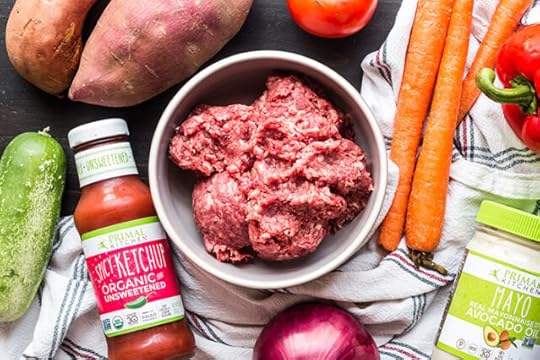 Ingredients
IngredientsBurger of choice
Roasted sweet potato rounds
Avocado oil mayo
Spicy mustard
Raw veggies
Whip up some burgers on the grill or stovetop (or better yet, use leftovers) for this lunch. Slice your favorite potato or sweet potato (or for a lower carb option, you can use rutabagas or turnips) and toss them in avocado oil. Roast them on a sheet pan at 400 degrees for 15 minutes, then flip them over and roast until they’re golden.
Make burgers by using the sweet potato slices as “buns” and top your burgers with sliced tomato and red onion. Use your favorite Primal Kitchen condiments like Pesto Mayo, Dijon Mustard, and Spicy Ketchup to put on top. Serve with your favorite raw veggies.
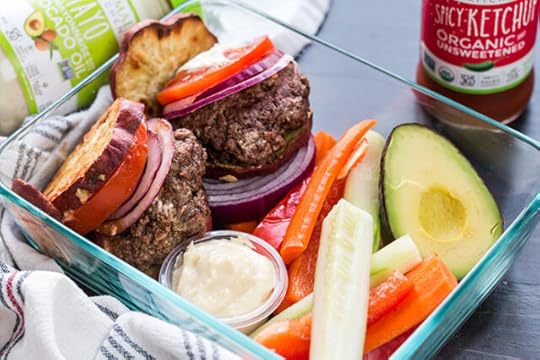
BIG Mason Jar Salads
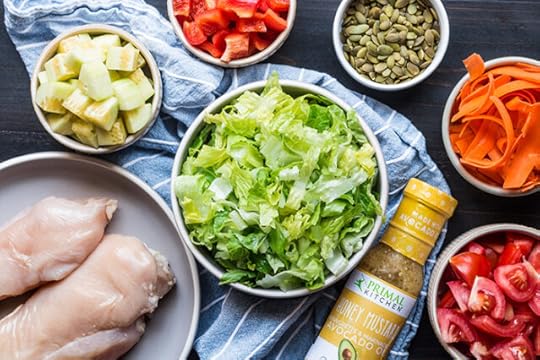
Ingredients
Romaine lettuce
Tomato
Carrot
Cucumber
Nuts or seeds of choice
Chicken breast or thighs
Dressing of choice
No tiny salads here! Use a 32oz or half gallon mason jar and fill with your favorite salad items. To prepare this salad, we marinated chicken (you can use breast or thigh) in your favorite dressing for a few hours. Roast the chicken on a sheet pan at 375 degrees until the internal temperature reaches at least 165 degrees Fahrenheit. Shred or chop the chicken, then layer it in your mason jars. For very large jars like this, we recommend pouring the salad into a large bowl before eating.
When you’re ready to eat, pour the dressing into the jar and give it a shake.
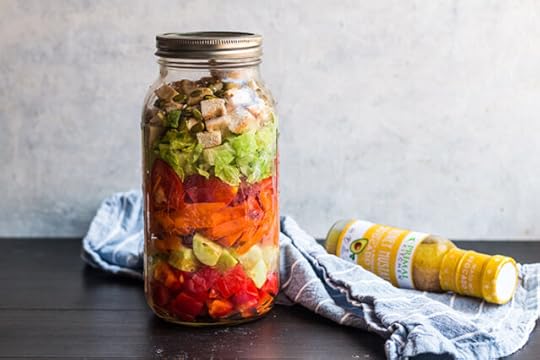
Deli Bento
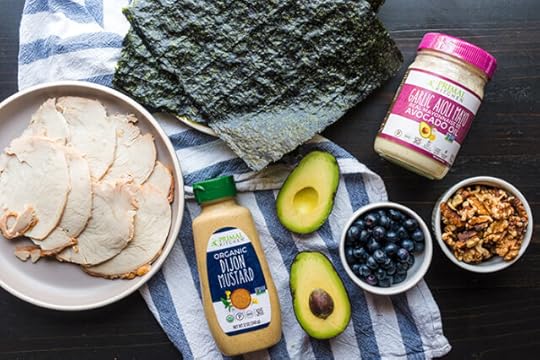
Ingredients
Roasted turkey slices
Avocado
Avocado oil mayo
Dijon mustard
Nori sheets
Walnuts
Blueberries
Who needs a regular sandwich when you can make these fun Primal Deli Bento Boxes? Use your favorite sliced meat (we like natural roasted sliced turkey), avocado and nori sheets to wrap them up in. Avocado oil mayo and dijon mustard are great condiments here. Serve alongside a primal snack mix like walnuts and fresh blueberries.
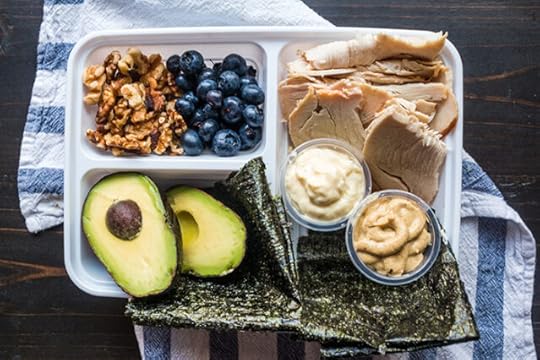
Tuna Salad Lunch
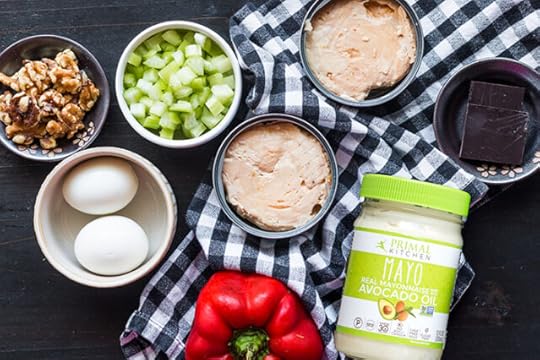
Ingredients
Canned tuna
Celery
Red bell pepper
Avocado oil mayo
Dijon mustard
Hardboiled egg
Walnuts
Dark Chocolate
Want a fun twist on tuna salad? Combine 1-2 cans of tuna with your favorite avocado oil mayo (and maybe some mustard, too), some chopped celery, and scoop the tuna into a cut bell pepper. Serve alongside hardboiled eggs and a handful of walnuts and dark chocolate.
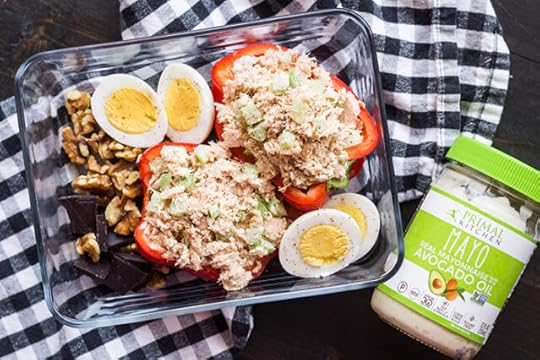
The post 5 Bento Box Lunch Ideas for Adults with Recipes appeared first on Mark's Daily Apple.



September 18, 2020
Weekly Link Love — Edition 99

Research of the Week
Researchers are exploring the “entities” people meet on DMT.
Hominids were cooking food in hydrothermal vents millions of years ago.
Plastic-degrading bacteria are rapidly evolving in the ocean.
Probiotics help obese children lose weight.
New Primal Blueprint Podcasts
Episode 446: Brad Kearns: Host Elle Russ welcomes Brad Kearns to the podcast.
Episode 447: Dr. Robert Silverman: Host Brad Kearns welcomes Dr. Robert Silverman to discuss COVID-19 and gut health.
Primal Health Coach Radio Episode 76: Laura and Erin chat with Tim Davis about breaking stigmas and beating addiction for good.
Media, Schmedia
Great layman’s overview of how sustainable ranching can work, be profitable, and produce tons of meat.
How livestock can prevent wildfires.
Interesting Blog Posts
Social Notes
Everything Else
Vitamin D is going mainstream. Love to see it.
Things I’m Up to and Interested In
Incredible study: Just one dose of wild blueberries improves cognitive performance in middle aged adults.
More evidence of our reawakening drive to roam and be nomadic: Hyundai gets into the RV game.
Imagine that: Class is more effective when it’s outdoors in a green space.
Important avenue of research: Potential ethnic differences in susceptibility to COVID-19.
Nice concept everyone can get behind: Megafauna nationalism.
Question I’m Asking
How’s school going for your kids?
Recipe Corner
Buffalo cauliflower, never would have thought of it.
Chinese sesame chicken, paleo-style.
Time Capsule
One year ago (Sep 12 – Sep 18)
Fitness Advice From A Primal Elder to Younger Groks: What to Focus On and What to Let Go Of – What’s important, what’s worth it.
Dear Mark: Psyllium, Hex Bar Deadlifts, Getting Strong vs Getting Big, Isometrics – Answering questions about all of this stuff.
Comment of the Week
“This is in response to Mark’s ‘Sunday with Sisson’ email about the beach.
I live in the Malibu area, and hiked the 75+ mile Backbone Trail with Santa Monica Mountains Trails Council. During the week-long hike, members of the organization gives talks about the local history and geography. This might also be mentioned in MDA blog, but I learned that there is a ‘kelp highway’ and humans may have followed it from Russia over the Bering Strait and down the Pacific Coast. The idea is that the kelp creates a steady environment for fish, so it’s an easy trail for people to follow.
I recall Mark has discussed how we process fish very well, and that a steady supply would create the conditions necessary to support the development of our big brains. I suspect that we are built to feel ‘at home’ and thus at peace in our niche near bodies of water.”
-Fascinating thought, Monica.
The post Weekly Link Love — Edition 99 appeared first on Mark's Daily Apple.



September 17, 2020
Intrinsic vs. Extrinsic Motivation, How to Get Going When You Don’t Feel Like It
 “I should work out today.”
“I should work out today.”
“I should eat better.”
“I should stop shoving food in my face.”
How many times a day do you find yourself using the word should? Most of my clients know what they should be doing to improve their health, but can’t seem to motivate themselves to actually do it. That’s why they come to me. Here’s the thing though. I can’t give you motivation, I can only give you the tools to motivate yourself.
So, if you’ve been feeling like you should be working out more or eating better or refraining from cutting yourself another sliver of pie, keep reading. I’ll be unpacking what motivation is, the reasons you get stuck, and how to finally get off your butt and take action.
What is Motivation, Anyway?
In its simplest terms, motivation is used to describe why you do what you do.That why is the driving force behind your actions, whether it’s taking a swig from your water bottle because you feel thirsty, going for a run because you paid money to hire a trainer, or smashing the alarm clock because you stayed up too late binge-watching Netflix. Your why will likely be influenced by a variety of intrinsic (internal) and extrinsic (external) motivators.
Examples of intrinsic motivators:
Running because it’s a stress reliever or feels fun
Eating a protein-forward breakfast because it keeps you satiated all morning
Doing yoga because it helps you clear your head
Filling your fridge with healthy foods because it saves you time and money
Organizing your space because it helps you feel calm
Examples of extrinsic motivators:
Losing weight to win a fitness challenge at work
Cleaning the house so your spouse doesn’t get irritated with your mess
Avoiding processed foods because your doctor or health coach told you to
Sprinting because that’s what the people in your FB feed are doing
Eating organic because you want others to perceive you as healthy
Let me make it really clear though that your motivation (and your why) are entirely internal processes, meaning it’s your own perception of a situation that makes you more or less motivated to do something. That’s why it’s important to discover your own deep-down reason for staying committed to the path you’re on — or choosing an entirely different path.
The Reasons You Get Stuck
Clearly, motivation involves more than just wanting something or doing it because you should. That said, even with the best laid plans and a handful of intrinsic and extrinsic motivators, why is it still so damn hard to actually do it?
In my private practice and with my students and graduates in the Primal Health Coach Institute, I talk a lot about Toward Motivation and Away from Motivation. While the former is designed to ignite a positive, transformative emotion, pulling you closer to the things you want (having more energy, feeling great in your clothes, boosting your confidence), the latter usually more negative, acting as a reminder of all the things you don’t want in life.
If you’re constantly telling yourself that you’re sick of feeling fat, foggy, and fatigued, guess what your brain is hearing? It hears that you’re fat, foggy, and fatigued — which often brings on feelings of fear, self-doubt, or self-pity. Trust me, that’s not the best talk track. And it’s the quickest way to sabotage yourself before you even start.
When you operate out of Away from Motivation, you’re more likely to use negativity to (try and) get motivated. But studies actually show that self-compassion and self-acceptance are better tactics — especially after you’ve had a setback. Researchers at the University of California found that after failing a test, participants who spoke kindly to themselves ended up spending more time studying before taking a re-test than participants who were angry or disappointed by their score.1 The self-compassionate group also reported that they had more motivation to view their struggles in a positive light when they practiced self-acceptance, which is a key part of self-compassion.
Go With the (Motivational) Flow
Like I said above, it’s your own perception of a situation that drives motivation. So how do you cultivate that internal positivity? Below we’ll look at 5 ways you can create your own intrinsic and extrinsic motivators so you can start taking action right now.
Find Your Why. Your Why is a belief, cause, or purpose that drives your behaviours. You might currently be working from someone else’s Why (could be a spouse that wants you to start exercising; a parent who thinks you should be thin; a belief that this is what you shoulddo). But your Why can only come from within you. And without figuring out what yours is, your motivation will likely fall flat, especially when obstacles start to pop up, which, by the way, they always do.
ACTION STEP: Think about what reaching your goal will give you. Is it the pleasure of having joints that don’t ache? Or the joy of being a role model to your kids? Or the freedom to finally get off your meds? Take a minute and jot down a few reasons (that truly resonate with you) why you feel compelled to take action.
2. Evaluate the Pros and Cons. When you have as many motives for why you want to reach your goal as motives for not reaching it, you create an inner conflict that basically keeps you stuck. You may want to eat healthy (and have a solid Whyto fuel your actions) but you might worry that you’ll never be able to eat anything “fun” again, so you sabotage yourself. Or maybe you feel great when you work out every morning, but the thought of getting unwanted attention from strangers once you lose the weight is a total turn off.
ACTION STEP: Consider how making these changes will impact you. First, write down the pros of this change. How will it affect you in positive ways? Now do the same for the cons. Write down how it will affect you in negative ways. Read though your list and cross off any cons that feel trivial or insignificant – or if they’re not really true for you. The secret to resolving inner conflict is to have more reasons why you want it, than reasons you don’t.
3. Put an End to Procrastination. You’re not always going to feel like getting up early to work out or planning a protein-packed breakfast, but there are tactics you can use to do it anyway. There’s a strategy called the 5 Second Rule that says you have 5 seconds to act on an instinct (that’s out of your comfort zone) before your brain shuts it down in an effort to keep you safe. Act within 5 seconds of the thought and you override its protective hold on you. Another strategy from habit guru, James Clear suggests eliminating distractions by making them more difficult to do. For instance, if watching TV keeps you from doing yoga, unplug it or hide the remote. Can’t stop hitting the snooze button? Put your phone in the other room while you sleep so you have to get out of bed to turn it off.
ACTION STEP: Try the 5 Second Rule technique by counting backward from 5 the moment you have an instinct to take action. Once you hit 1, get moving! For James Clear’s strategy, think about the things that cause you to procrastinate, then make them more difficult to do by removing the temptation.
4. Reward Yourself. Sometimes big goals can feel intimidating, making it harder to get motivated. For a simple work-around, try creating smaller goals and then rewarding yourself when you reach those goals. You might lack the motivation to start exercising because you have 60 pounds to lose, but consider breaking it down into 5- or 10-pound increments and rewarding yourself with a new workout top or healthy dinner out every time you reach one of your mini goals.
ACTION STEP: Jot down the big goal you’d like to accomplish. Then create smaller goals (if necessary) and write down how you’ll reward yourself when you reach them. Just make sure your rewards don’t sabotage your efforts. Rewarding a tough workout with a few beers or plate of nachos is kind of counterproductive.
5. Visualize your Success. Used by everyone from athletes to entrepreneurs, visualizing your success is a proven motivational tool — especially when it’s paired with an elevated emotion like joy or excitement. When you paint a clear picture of what success looks like in your mind, it becomes less abstract and more obtainable. Plus, when you spend time on the things you want (looser fitting clothes, better sleep, chasing your kids around without stopping to catch your breath) versus the things you don’t want (feeling bloated, tossing and turning, and sitting on the couch missing out) your brain becomes more receptive to finding opportunities that align with your goal.
ACTION STEP: Every morning before getting out of bed, take 2 minutes to visualize yourself as if you’re already successful. Imagine what it would feel like to have achieved your goal, and pay attention to the positive feelings that automatically come up when you do this exercise.
5 Ways to Get Motivated Now
Remember, when you tell yourself that you should be doing something, you’re really just reinforcing the idea that you’re not doing it. So, first, wipe the word should from your vocabulary, then dive into these 5 ways to cultivate your own sense of motivation:
· Find your Why
· Evaluate the Pros and Cons
· Put an End to Procrastination
· Reward Yourself
· Visualize Your Success
What’s worked for you? Tell me how you get motivated when you’re not feeling it.
References https://journals.sagepub.com/doi/10.1177/0146167212445599
The post Intrinsic vs. Extrinsic Motivation, How to Get Going When You Don’t Feel Like It appeared first on Mark's Daily Apple.
 [image error]
[image error]
[image error]
September 16, 2020
Does Your Digestion Need a Tune-up?
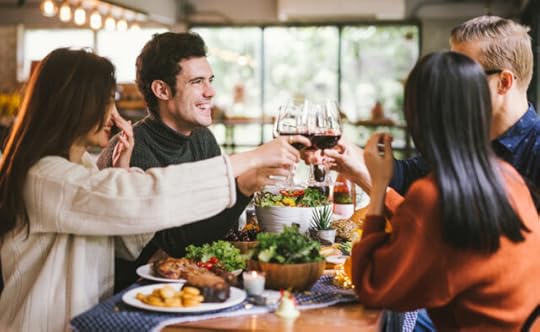 Well, does it?
Well, does it?
We’re all going to be putting food in our bodies just about every day for the rest of our lives. Most of us will do it several times a day. We’ll chew it, send it down the esophagus into our stomach, and expose it to gastric juices and digestive enzymes. We’ll strip it of nutrients and send the excess down to the colon for dismissal, feeding resident gut bacteria along the way. The whole process should go smoothly. There shouldn’t be any pain or discomfort, bloating or constipation. Oh sure, nobody’s perfect, and there will be slow-downs or speed-ups from time to time, but in general a vital, fundamental process like digestion shouldn’t even register in our waking, conscious lives.
But sometimes it does.
Instantly download your Guide to Gut Health
Symptoms of Digestion Problems
Sometimes digestion can be downright unpleasant, or even unproductive. The symptoms are familiar:
Bloating. Distended belly. Feeling overly full and unwieldy. Same weight but the pants don’t fit.
Excessive gas. No need to define it. You just know it when you see (hear) it.
Diarrhea. Acute (occasional) diarrhea that goes away immediately doesn’t indicate poor digestion, but protracted or chronic diarrhea is a warning sign.
Constipation. Same deal with constipation: acute normal, chronic not.
Stomach pain. Persistent gut pain should never be ignored.
Bleeding or pain on the toilet. Elimination should be painless.
Heartburn, or acid reflux. Although most people assume heartburn and acid reflux are caused by too much stomach acid, it’s actually the opposite: inadequate stomach acid is usually the culprit.
The Digestive Process: Troubleshooting Top to Bottom
To get to the bottom of these symptoms and hopefully fix them, let’s look at the actual process of digestion. We’ll go step by step down the line to identify and offer solutions for various issues that can arise at each.
What happens when you eat something?
The stops along the digestive route involve:
Sensing and signaling
Oral digestion, or chewing
Mechanical digestion, in the stomach
Duodenum digestion
Small intestine digestion
Colon digestion
Here’s how it works.
Sensing and Signaling
You start digesting before you’ve even taken your first bite. Have you ever smelled burgers grilling, and you mouth started to water? Certain aromas can signal to your body that food is coming, and you begin to salivate and secrete digestive enzymes.
Even thinking about food can trigger a response.
Oral Digestion, or Chewing
Now, you’ve taken a bite.
First, you chew your food. Chewing is the first step in digestion. You physically break it up with your teeth into smaller pieces, increasing the surface area for digestive enzymes to access. Most of those enzymes appear later in the gut, but some appear in the saliva and start working immediately in the mouth during the chewing process.
Your taste buds communicate what you’re eating so that your body starts getting the right digestive juices flowing. For example, if you ate something sweet, you’ll make insulin. If you’re eating a fatty food, you’ll start secreting bile and enzymes.
Salivary amylase begins converting starch into sugar for easier digestion. Chew a potato for long enough and it’ll start tasting sweet.
Lingual lipase begins digesting the fats you eat. This is more important in babies, who express very high levels of lingual lipase in order to optimize their calorie intake from breastmilk. It still has an effect in adult fat digestion.
How to optimize oral digestion
Chew more: The longer you chew, the better you digest your food. In one study, healthy adults who chewed 50 times for each bite ended up eating fewer calories than those who chewed 15 times per bite, a strong indication of more efficient digestion and nutrient extraction.1 They were getting “more” out of their food simply by chewing it up more.
Heed your salivary amylase levels: How much salivary amylase you produce is determined by your genetics, with historically agricultural (and thus starch-consuming) populations tending to possess more copies of the salivary amylase gene than other populations. There’s no good way to test salivary amylase gene status because the commercial genetic analysis sites don’t cover it. You’d need a more specific (and expensive) test for that. Ancestry can be a rough proxy; try to match your carb intake with the carb intake (and thus amylase copies) of your recent ancestors. But whatever number of amylase copies you (might) carry, chewing more times per bite will increase the efficacy of the salivary amylase you do produce.
As for meat and other animal foods which salivary amylase doesn’t affect, chewing is still important because it breaks apart the fibers and makes the nutrients contained therein more accessible to protein-digesting enzymes (proteases) in the stomach.
Mechanical Digestion, in the Stomach
Leaving the mouth, the food travels down the esophagus on into the stomach, where hydrochloric acid and a protein-degrading enzyme called pepsin break the food down into a big semifluid mass of partially-digested food components, water, enzymes, and acid known as chyme. The stomach walls undulate (move up and down) and mix the chyme,
How to Optimize Stomach Digestion?
Get your thiamine. Thiamine is a B-vitamin involved in hydrochloric acid production. If you want optimal stomach acidity—and you definitely do want it—you need to be replete in thiamine. The best source of thiamine is pork.
Watch the antacids. While heartburn meds can make a person feel better in an acute case of heartburn, they do so by inhibiting production of hydrochloric acid, which makes the stomach more alkaline and worsens your digestion in the long run. Pepsin cannot work without adequate acidity.
Try bitters. Post-meal bitters stimulate production of hydrochloric acid and assist many of the digestive organs, making the whole operation run more smoothly. But they must be bitter. Covering up the bitter flavor with something sweet mitigates the beneficial effect on digestion.
Get enough sodium. Low sodium levels reduce hydrochloric acid production. Make sure you’re salting your food to taste, as our moment-to-moment desire for salt is a good marker for sodium requirements. As long as you’re not eating packaged junk food, you won’t crave too much salt.
Try supplemental hydrochloric acid. A little betaine HCl, especially with protein meals, can really help if your acid production is too low. If you take betaine HCl and you feel a burn, you probably don’t need it.
Duodenum Digestion
Since the stomach is too acidic for amylase to work, the chyme migrates down to the duodenum, the first section of the small intestine immediately after the stomach where the pH is more alkaline. The pancreas produces protein-digesting enzymes as well as amylase and delivers them to the duodenum, where the full range of digestive enzymes can get to work liberating nutrients for absorption down the line. This is also where bile is introduced to assist in fat digestion.
Eat meals rather than graze. The human digestive system operates best when it encounters whole meals with plenty of time between subsequent meals, rather than a steady stream of incoming food. It even tries to enforce this; when a bolus of chyme enters the duodenum, the opening leading from the stomach to the duodenum tightens up to prevent more food from coming in. Overriding this with constant snacking will only impair your digestion and back things up.
Go for a walk. A short walk after eating speeds up the transition of food from the stomach through the duodenum into the small intestine. It “gets things moving,” in a good, beneficial way.
Small Intestine Digestion
After softening up in the duodenum, the chyme passes on into the small intestine where the bulk of nutrient absorption occurs. All along the intestinal walls lie villi — microscopic finger-like projections that increase the surface area of the intestinal lining and pluck nutrients from the passing slurry to be absorbed and assimilated. (You may have heard of villi in the context of gluten. Gluten can wipe out the villi in some people, leading to nutritional malabsorption.)
Optimize your serotonin. 95% of the serotonin in our body occurs in the gut; it’s one of the primary regulators of intestinal peristalsis — the muscular contractions that move and mix food through the digestive tract.2 I’ll have a much more in-depth post in the near future on this topic.
Fix leaky gut: Leaky gut isn’t just about allowing in pathogens and unwanted, allergenic food components into your bloodstream. It also impairs nutrient absorption and digestion in the small intestine. Go through this post and make sure you’re practicing excellent tight junction hygiene.
Pay attention to FODMAPs: Not everyone with digestive issues has to do this, but anyone who gets bloating, belly pain, excessive gas, and many of the other symptoms of poor digestion after eating should analyze their diet for FODMAPs and do an elimination trial. FODMAP foods include a wide range of fermentable fibers, sugars, vegetables, and fruits that have been shown to provoke uncontrollable and uncomfortable gut issues. These are often foods we consider to be healthy. Read the posts I’ve done on FODMAPs and follow the advice listed therein if you suspect you may have a problem with them.
You can also get tested for SIBO to see whether eliminating FODMAPs will benefit you.
Colonic Digestion
You don’t actually “digest” anything in the colon. Rather, you gather and expel the waste — mostly fiber — that’s left over from digestion. Some of that “waste” is food for the gut bacteria who live in your colon. So someone’s digesting the stuff, just not you.
Eat some prebiotic fiber. Ironically, sometimes you need to eat stuff you can’t digest in order to improve your digestion over the longterm. Fermentable, prebiotic fibers like inulin and resistant starch are some of the best-studied examples. They feed the (mostly) good gut bacteria, who in turn produce short chain fatty acids that power your colonic cells and improve your metabolic health.
Take probiotics. Certain probiotics have been shown to reduce bloating and belly pain, improve GI symptoms, improve IBS symptoms, reduce leaky gut, and reduce antibiotic-related diarrhea.34567 I created Primal Probiotics with precisely these probiotics to tip the balance in your favor.
Get Primal Probiotics here
Digestion must be approached as a single unit. You don’t just pick one of these tips to try. You do them all, together, if they apply to you.
References https://pubmed.ncbi.nlm.nih.gov/29767425/https://pubmed.ncbi.nlm.nih.gov/11051338/https://www.ncbi.nlm.nih.gov/pubmed/19332970https://www.ncbi.nlm.nih.gov/pubmed/19922649https://www.ncbi.nlm.nih.gov/pubmed/21418261https://www.ncbi.nlm.nih.gov/pubmed/3938349http://onlinelibrary.wiley.com/doi/10.1111/j.1365-2036.2004.02274.x/abstract
The post Does Your Digestion Need a Tune-up? appeared first on Mark's Daily Apple.



September 15, 2020
The Pandemic’s Toll on Mental Health and Relationships: What Can We Learn?
 When Mark asked me to write a post about the toll the pandemic is taking on mental health and relationships, I didn’t want simply to detail the ways it’s hard to live through a pandemic. Nor did I want to throw a bunch of statistics at you about how many people are having a difficult time. You know that it’s like living in the world’s least entertaining Groundhog-Day-meets-dystopian-thriller film.
When Mark asked me to write a post about the toll the pandemic is taking on mental health and relationships, I didn’t want simply to detail the ways it’s hard to live through a pandemic. Nor did I want to throw a bunch of statistics at you about how many people are having a difficult time. You know that it’s like living in the world’s least entertaining Groundhog-Day-meets-dystopian-thriller film.
If you’re like me, you’re sick of kvetching about 2020. The fact is, though, that I don’t know anyone, myself included, who isn’t struggling in one way or another right now.
After a lot of reflection, I’ve concluded that a big reason why 2020 is so draining is that our usual coping strategies don’t work like we want or expect. Most are aimed at reducing the source of our distress or dealing with the emotional aftermath. This pandemic is ongoing. We’re stuck in the middle of it, with no end in sight, and no way to speed the process along.
That doesn’t mean we’re helpless, though. Personally, I’m a huge believer in practicing self-compassion as a means of coping, almost no matter the situation. I’m talking a formal practice of self-compassion, as outlined by Dr. Kristin Neff and others.1 This requires self-awareness—mindfully tuning in to what is happening in your brain and body—and then offering yourself understanding and grace for what you’re feeling and how you’re responding. It’s perfect for situations like the one we’re in now, where we have little control over our suffering (the term used in the self-compassion literature), but we desire peace.
Because of my background, in the quest for self-awareness, I always look at situations through the dual lens of ancestral health and social psychology. Ever the optimist, I also look for opportunities to learn and do better when possible. Here’s what I’ve come up with so far.
Instantly download your Guide to Gut Health
Facing the Unique Challenges of Living Through a Pandemic
I said I didn’t want to gripe, but let’s acknowledge that the pandemic is taking a serious toll. Survey after survey shows that more people are struggling with depression and anxiety. Distance learning is a challenge. Healthcare workers are under a tremendous amount of stress, as our other essential workers. People are sleeping poorly. Substance abuse is on the rise. 2 3
Which is to say, 2020 is exhausting, for lots of reasons.
Stressors Are Meant to Be Acute
Mark talks about this all the time. Humans are best equipped to deal with brief, intense stressors. We fight, flee, or freeze, and then, assuming a saber-toothed tiger hasn’t eaten us, we recover.
Everything about the present situation is misaligned with our genetic expectations. We’re simply not built to withstand long-term, unyielding stress—not from our jobs, chronic cardio, chronic sleep deprivation, and certainly not from six months of pandemic with no end in sight.
Remember back at the beginning of the pandemic where people were all, “Use this time to work on a new skill, build your side business, Marie Kondo your whole house!”
Lololol.
Now we’re beating ourselves up for feeling unproductive, lacking the motivation to exercise, and craving comfort foods. Instead, we should be lowering our expectations and telling coronavirus, “It’s not me; it’s you.”
Staying Afloat
When it comes to stress, even chronic stress, the goal is usually to eliminate it as much as possible. Here, though, our only real option is to try to keep our heads above water while we wait for things to get better. It doesn’t surprise me that substance abuse seems to be on the rise. When we can’t control stressors, sometimes it seems easier to numb out. The problem is, numbing isn’t coping. It’s avoidance. Drinking a bottle of wine while binge-watching a show may be great escapism, but at best, it’s a temporary fix.
In many cases, our best option is, in fact, self-compassion, radical acceptance, whatever you want to call it, plus a heaping dose of self-care. The trick, I think, is to acknowledge that the goal isn’t to alleviate stress or feel “normal.” It’s to stay afloat long enough to see the other side.
Questions I’m asking myself:
Am I expecting too much of myself, or failing to give myself necessary grace, given the amount of stress I can’t control
Am I using numbing strategies instead of coping strategies?
Mismatch Between Basic Needs and Coping Strategies
I’ve come to believe that many mental and emotional hardships are due to a mismatch between why we’re struggling and what we’re told to do about it.
Let me back up. Psychologists have proposed various models of basic human needs. You’re probably familiar with Maslow’s hierarchy, for example. At the base of Maslow’s pyramid are basic physiological and safety needs (food, warmth), then you work your way up to belongingness (relationships), esteem (pride, accomplishment), and finally self-actualization.
Academics don’t put a lot of stock in it, but it’s stuck around for more than seven decades because it has high face validity. That is, it feels right. We need to attend to physiological and safety needs before we can worry about connecting to other people, and certainly before becoming the best version of ourselves.
Those foundational needs are always more pressing, and all of us are facing novel threats to our safety. Not surprisingly, data from two polls conducted by the Kaiser Family Foundation and one from the U.S. Census Bureau confirm that the mental health toll has been greater for people who have experienced job loss or income insecurity.4 5
Yet, much of the coping advice is aimed at those higher-tier needs—connecting to others, learning a new skill, becoming a zen master. I’ve been guilty of this, too. I love talking about self-care. At the same time, I understand why people are sick of being told to take a bubble bath or go for a walk when they’re worried about paying rent. (I do think social connection is always important.)
Melt your stress away with Adaptogenic Calm
A Problem of Self-Determination
My favorite psychological needs theory—doesn’t everyone have one?—is self-determination theory. SDT posits that humans have three basic psychological needs: autonomy, competence, and relatedness. Unlike Maslow’s hierarchy, there is a boatload of research demonstrating how meeting those fundamental needs, or not, affects motivation and well-being.6
It seems to me that most common coping strategies address competence (developing mastery) or relatedness (connecting to others). However, loss of autonomy—the freedom to control our own actions—is undoubtedly a primary reason we’re struggling.
The problem is, there’s not much we can do about that. The best option is to focus on controlling the things we can control and accepting those we can’t (major serenity prayer vibes, here). I’m not suggesting that we should be reasserting our autonomy by flouting the rules and doing whatever we want, virus be damned. No, the point is to understand why things still feel hard even when we’re trying our best to practice self-care so that we might give ourselves grace.
Questions I’m asking myself:
Am I meeting myself where I’m at, or am I using generic coping strategies that, while well-meaning, aren’t really what I need?
Am I blaming myself or feeling guilty for struggling, instead of accepting that the pandemic is hard in ways that are hard to cope with directly?
What Can We Learn from People Who are Doing Well?
I’m fascinated by people who are actually doing better now than before. Some kids are thriving at home, free from the social and academic pressures of traditional schooling. Lots of adults are realizing that they are happier and more productive working from home.
Getting back to the topic of this post, when I started to dig into the data on how the pandemic is affecting relationships, I expected to find dire news. I didn’t. While it’s logistically harder to see friends or travel to visit distant relatives, many people have seen their close relationships improve.
FThe Behavioural Science and Health Research Department at University College London is conducting weekly surveys looking at the psychological response to the pandemic, along with other socioemotional and behavioral variables. More than 90,000 people have responded. As of writing, data are available for the first 23 weeks here.
In July, week 16, the researchers asked about relationships. The majority of respondents said the pandemic had not changed their relationships with spouses, friends, family members, or coworkers. More people felt that their friendships had suffered since the beginning of the pandemic, compared to the number whose friendships improved—22 versus 15 percent of respondents, respectively. The data were similar for coworkers. However, relationships with some family members and neighbors were more likely to have improved:
27 percent said their romantic relationship got better, while 18 percent felt it was worse
35 percent reported their relationship with children living at home had improved, versus 17 percent who said it had suffered
26 percent had better relationships with neighbors, versus 8 percent worse
I really wish there was more attention to being paid to those people. Why are they doing better? What’s their secret? It must have something to do with the time we have to invest differently in relationships now, but is there more to it than that? Academics are going to be writing about this for decades, I’m sure.
Shaping a “New Normal”
Since we have no choice about living through a pandemic, I hope we can at least learn from it.
When we go back to “normal,” it won’t be—and shouldn’t be—the normal we knew before. The ways people are suffering and thriving both offer important lessons about human nature, our ability to cope, and the ways we do and do not support one another effectively. That some people are doing better during an arguably terrible time is telling. It says a lot about the challenges and shortcomings of our pre-pandemic way of life.
The question is, will we heed the lessons?
What about you—how are you doing, really? Will you go back to “business as usual,” or have you gained any insights from the past six months that will change how you approach things in the future?
References https://self-compassion.orghttps://jamanetwork.com/journals/jamanetworkopen/fullarticle/2770146https://www.kff.org/coronavirus-covid-19/issue-brief/the-implications-of-covid-19-for-mental-health-and-substance-use/https://www.kff.org/coronavirus-covid-19/issue-brief/the-implications-of-covid-19-for-mental-health-and-substance-use/https://www.census.gov/programs-surveys/household-pulse-survey/data.htmlhttps://richarddehoop.nl/upload/file/self-determination.pdf
The post The Pandemic’s Toll on Mental Health and Relationships: What Can We Learn? appeared first on Mark's Daily Apple.



September 14, 2020
Why We Should All Be Eating Organ Meats
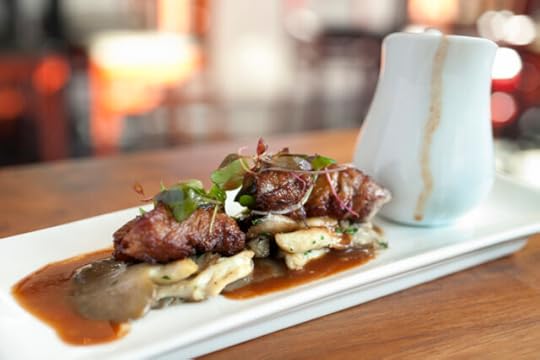 Today we welcome a post by guest author Ashleigh VanHouten, health and nutrition journalist, public speaker, certified health coach, and host of the Muscle Maven Radio podcast. Here, she explains why we’re missing out if we’re only eating boring boneless cuts of meat from the grocery store, and makes the case for eating nose-to-tail, for both our health and for our enjoyment. Her new cookbook, It Takes Guts, is available for preorder and hits the shelves in late October.
Today we welcome a post by guest author Ashleigh VanHouten, health and nutrition journalist, public speaker, certified health coach, and host of the Muscle Maven Radio podcast. Here, she explains why we’re missing out if we’re only eating boring boneless cuts of meat from the grocery store, and makes the case for eating nose-to-tail, for both our health and for our enjoyment. Her new cookbook, It Takes Guts, is available for preorder and hits the shelves in late October.
“It’s good for you and for the planet – and it’s easier and tastier than you think!” – Ashleigh VanHouten
Modified excerpt from It Takes Guts, shared with publisher permission.
If I had a dollar for every time someone told me, “I just can’t get my head around eating [insert type of organ meat here] because I didn’t grow up eating it,” I could retire now and live out the rest of my days eating animal hearts on a beach somewhere — but I have a secret for you. I didn’t grow up eating organ meat, either; I grew up eating cereal and bread and chicken breast, and while I always gravitated toward animal products, I certainly wasn’t eating liver or sweetbreads.
But as someone who has dedicated their career to researching, studying, and experimenting with nutrition, I believe strongly that one bite of something new won’t hurt you, and it just might open up a whole new world of pleasure and health. It’s a fact that organs are generally the most nutrient-dense parts of an animal, so if we can find fun and creative and even subtle ways to enjoy them, we’re winning. And by eating the whole animal, we’re also honoring and respecting the beings who sacrificed for our dinner plates by ensuring none of it is wasted.
I wrote my nose-to-tail cookbook It Takes Guts because I am passionate about honoring the animals we’re eating, and enjoying the full bounty of delicious and healthy options available to us. As the saying goes, the way you do anything is the way you do everything, and I believe we should all be approaching our plates, and our lives, with a sense of adventure and enthusiasm.
Here’s a quick breakdown of some of the reasons why eating organ meats is a good idea:
It’s Sustainable
It would be wasteful to buy a huge house and use only one or two rooms, right? Adopting a whole-animal approach reduces waste, and buying from local farms and butchers helps decrease the carbon footprint created when meat is brought to you from far-flung places. In the process of breaking down an animal, less than half of it will usually end up as boneless cuts,
or the type of meat you normally pick up at a grocery store. Much of the rest is bone, hide, blood, and organs – the latter being the most nutrient-dense part of the animal, which we are essentially giving away to then eat the less nutrient-dense muscle meat!
If you’re reading this, you probably eat animals, and if you’ve accepted that eating animals is a natural part of living, the best way forward is to ensure that the animals you’re eating lived a healthy, natural life and were slaughtered humanely, and that we honor the animal’s sacrifice by not wasting any of it over arbitrary (and misguided) beliefs that some part of the animal are acceptable to eat and others aren’t.
It’s Healthy
It’s a fact: organ meats like liver, heart, and kidney are nutritional powerhouses, not just for their individual nutrients but for the synergistic effect of consuming these nutrients together. Nutrients like vitamin A, vitamin D, and magnesium work together with other food-based compounds. That’s why taking many of these nutrients on their own (in pill form, for example) doesn’t have as much of a positive effect on your body.
And to debunk a big myth about these cuts, it is untrue that organ meats like liver and kidney store and contain toxins. Organs like the liver filter toxins, usually moving them to the kidneys, from which they are eventually expelled through the urine. Toxins are removed from a healthy, well-functioning animal’s body via these miraculous organs just like they are in ours; eating fresh, healthy organs is the same as eating fresh, healthy muscle meat. If toxins do linger in the body, they are generally stored in fat cells (this goes for us too), which is why it’s crucial to source high-quality animal protein that is raised without pesticides or antibiotics, because that’s where they’ll end up: in your delicious, fatty rib-eye.
Organ meats are so nutrient-dense that you can eat very small amounts and get more benefit than you would from nearly any other food on the planet. A few ounces of beef liver contains your daily needs for many nutrients, including iron, copper, zinc, folate, choline, and vitamins A and B12. So even if I can’t convince you to love the taste of organ meats, I hope I can help you understand that these are superfoods that can dramatically improve your health.
It Saves You Money
Often, organ meats are less expensive than muscle meats simply because they aren’t in high demand. Imagine the nutrient-dense parts being sold for scraps while the basic protein is sold at a premium! Unlike prime cuts of grass-fed beef, grass-fed beef liver and heart are pretty cheap. A beef tongue can feed a party of six for about ten bucks; chicken hearts are often sold for a few bucks a pound; and you can buy a bag of tasty, protein packed chicken gizzards that will serve a whole family for less than you’d pay for a fancy salad at your local fast-casual restaurant.
If you want to get the best nutritional bang for your buck with protein, your best bet is to throw some offal in there. Make friends with your local butcher, too, so you learn about and source the best stuff!
It’s Fun (and Ancestral!)
If you can reframe your perceptions of organ meat being “gross” or extreme and see it for what it really is—just a different part of the animal you’re already eating, and a much more nutritious part at that—you can start having fun with different recipes and preparations.
Nose-to-tail eating is also a celebration of culture and history, honoring the traditional foods off different countries; a time when people were less swayed by grocery store marketing and more driven by instinct; when we gave more respect to the time, skill, and labor of providing meals for our families, and when nourishment mattered more than hyperpalatability.
It’s Tasty (Really!)
Don’t knock it ’til you’ve tried it—that’s what I’m always telling my skeptics. While certain organ meats have stronger flavors and unique textures and may never appeal to some people, the same can be said for less controversial foods (don’t even get me started on broccoli—now that’s an acquired taste!) I know I’ll never win everyone over, but if you’re willing to at least try,
I think you’ll be pleasantly surprised at how delicious, delicate, and decadent offal can be. If you’d like to learn more about the health, history, and deliciousness of organ meats, including my personal journey and more than 75 offal-based recipes created by myself and a range of other fantastic chefs, you can pre-order my book, It Takes Guts, now!
 Ashleigh VanHouten is a health and nutrition journalist, public speaker, certified health coach, and self-proclaimed muscle nerd. She has written for Paleo Magazine for more than eight years, along with a number of other health publications. She hosts the Muscle Maven Radio podcast, which has been downloaded more than 1.5 million times, where she’s interviewed some of the biggest names in health and wellness, including Mark Sisson, Dave Asprey, and Steph Gaudreau. She’s also worked with other top-rated health-related podcasts, such as Barbell Shrugged, Muscle Intelligence, and Paleo Magazine Radio. Combining her formal education and professional experience in marketing and communications with her passion for healthy eating, exercise, and learning, Ashleigh works in a consulting role for a number of professionals in the health and wellness world, working alongside individuals like Dr. Gabrielle Lyon, Ben Pakulski, and Elle Russ. Find out more at ashleighvanhouten.com.
Ashleigh VanHouten is a health and nutrition journalist, public speaker, certified health coach, and self-proclaimed muscle nerd. She has written for Paleo Magazine for more than eight years, along with a number of other health publications. She hosts the Muscle Maven Radio podcast, which has been downloaded more than 1.5 million times, where she’s interviewed some of the biggest names in health and wellness, including Mark Sisson, Dave Asprey, and Steph Gaudreau. She’s also worked with other top-rated health-related podcasts, such as Barbell Shrugged, Muscle Intelligence, and Paleo Magazine Radio. Combining her formal education and professional experience in marketing and communications with her passion for healthy eating, exercise, and learning, Ashleigh works in a consulting role for a number of professionals in the health and wellness world, working alongside individuals like Dr. Gabrielle Lyon, Ben Pakulski, and Elle Russ. Find out more at ashleighvanhouten.com.
The post Why We Should All Be Eating Organ Meats appeared first on Mark's Daily Apple.



September 12, 2020
Keto Cubano (Cuban Sandwich) Sliders Recipe (Gluten Free)
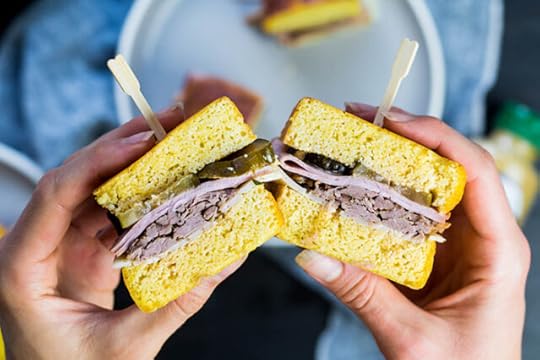 When you think of a Cubano, or Cuban Sandwich, you probably think of some combination of flavorful pork, Swiss cheese, pickles, and mustard on bread, grilled until the layers meld into a salty, tangy, warm pork and cool pickle flavor bomb. This Keto Cubano Sliders Recipe gives you the Cuban Sandwich experience you crave without messing up your carb count.
When you think of a Cubano, or Cuban Sandwich, you probably think of some combination of flavorful pork, Swiss cheese, pickles, and mustard on bread, grilled until the layers meld into a salty, tangy, warm pork and cool pickle flavor bomb. This Keto Cubano Sliders Recipe gives you the Cuban Sandwich experience you crave without messing up your carb count.
Cuban Sandwich Sliders are versatile, and if you make the pork and bread ahead, you can throw them together for any occasion. Virtual learning with the kiddos? Throw them together for a lunch that makes everyone happy. Having your quarantine pod squad over for a late summer get-together before the fall chill sets in? Cubano Sliders will be a hit with everyone. Weeknight dinner? Serve sliders along with your big-ass salad and call it good.
A few tips:
The sandwich bread linked in the recipe browns very nicely in a pan or on a griddle. When pressing the sandwich, use a heavy pot or pan and maintain pressure until it’s time to flip the sandwich over.
You can use pork tenderloin instead of the pork butt (shoulder) if you’d like, but will need to adjust cooking time since the cut is thinner and leaner than the shoulder.
Ready to get started?
Keto Cubano (Cuban Sandwich) Sliders Recipe (Gluten Free)
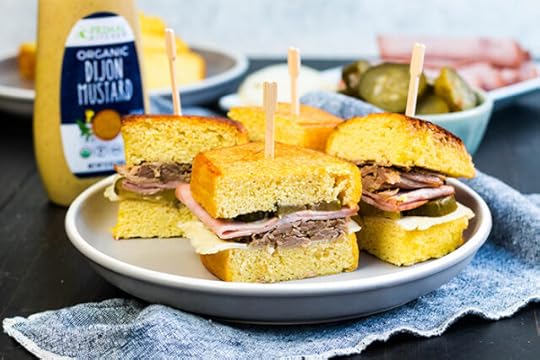
Serves: 8
Time in the kitchen: 2 hrs 2o min, including 2 hrs hands-off roasting time
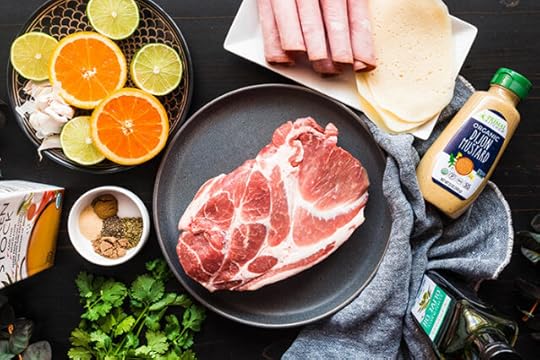
Ingredients
For the Pork:
2 lbs. boneless pork butt (shoulder roast)
2 Tbsp. avocado oil
4 garlic cloves
Juice from 1/2 lime
Juice from 1/2 orange
Zest from 1/2 lime and orange
1/2 Tbsp. cumin
1/2 Tbsp. oregano
1 tsp. coriander
3/4 tsp. salt
1/2 tsp. garlic powder
1/4 tsp. black pepper
2 cups chicken broth
For the Sandwich:
8 slices sliced ham
4 slices swiss cheese, cut in half
8 pickles
Dijon mustard
1 Batch Keto Sandwich Bread
1 Tbsp. butter
Directions
In a bowl, combine half of the oil, lime juice, orange juice, lime and orange zest, cumin, oregano, coriander, salt, garlic powder and black pepper.
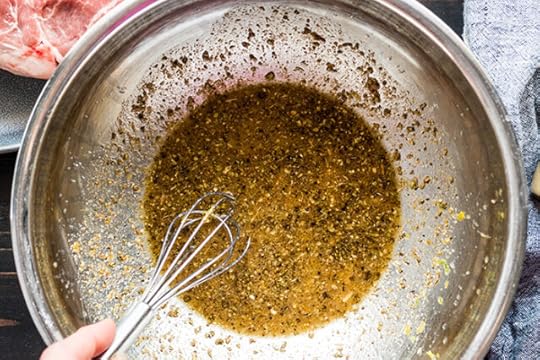 Pour it all over the pork butt and place it in the fridge for 1 hour.
Pour it all over the pork butt and place it in the fridge for 1 hour. 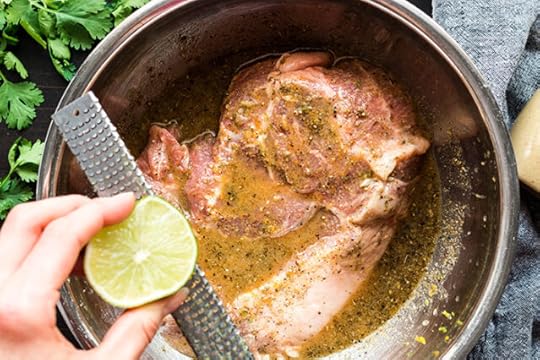 Preheat your oven to 325 degrees. Heat a dutch oven over medium heat with the remaining oil. Once hot, add the garlic and stir until fragrant. Remove the pork from the marinade and place it in the pot.
Preheat your oven to 325 degrees. Heat a dutch oven over medium heat with the remaining oil. Once hot, add the garlic and stir until fragrant. Remove the pork from the marinade and place it in the pot. 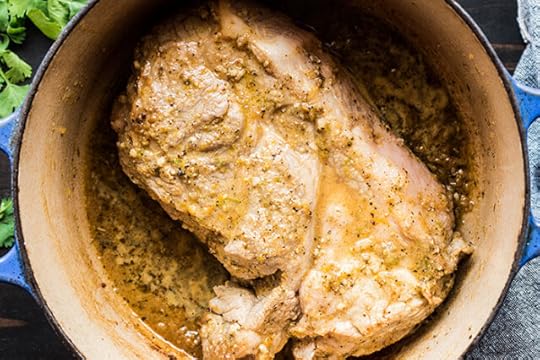 Allow the meat to sear for about 2 minutes on both sides. Pour the marinade into the pot as well as the chicken broth. Bring the liquid to a boil and then reduce the heat to a simmer.
Allow the meat to sear for about 2 minutes on both sides. Pour the marinade into the pot as well as the chicken broth. Bring the liquid to a boil and then reduce the heat to a simmer.
Cover the pot and place it in the oven for about 2 hours. At this point, flip the meat over and cook for an additional 30-45 minutes, or until you can shred the pork. Shred the meat and place the pot back into the oven uncovered and increase the oven temperature to 375 degrees. Allow the pork to roast for about 30 minutes, or until some of the liquid has evaporated and the meat is tender. Set the meat aside.
Prepare your Keto Bread in a loaf pan and bake according to the instructions. 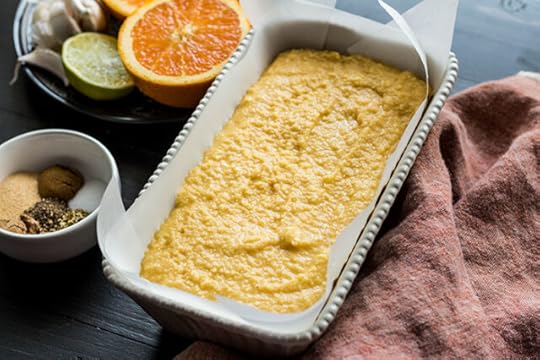 Slice your Keto sandwich bread into 16 slices (or for a thicker bread, cut into 12 slices).
Slice your Keto sandwich bread into 16 slices (or for a thicker bread, cut into 12 slices).  Take two slices for your first sandwich. Spread a little Primal Kitchen Dijon or Spicy Mustard on one side, and then top with the pickles, ham, and a little of the shredded cuban pork. Place the Swiss cheese on top of the pork and then top with the second slice of bread.
Take two slices for your first sandwich. Spread a little Primal Kitchen Dijon or Spicy Mustard on one side, and then top with the pickles, ham, and a little of the shredded cuban pork. Place the Swiss cheese on top of the pork and then top with the second slice of bread.
Heat a small amount of butter in a small skillet. Swirl it around and once hot, carefully place the sandwich in the pan. Use another skillet or a pot to carefully press down on the sandwich.  Maintain the pressure on the sandwich until the cheese melts slightly and the bread begins to brown slightly. Turn the sandwich over and repeat on the other side until both sides are golden. Repeat with the remaining sandwiches. Slice your sandwiches in half and enjoy!
Maintain the pressure on the sandwich until the cheese melts slightly and the bread begins to brown slightly. Turn the sandwich over and repeat on the other side until both sides are golden. Repeat with the remaining sandwiches. Slice your sandwiches in half and enjoy!
Nutrition Info (makes 8 sandwiches):
Calories: 710
Total Fat: 59g
Total Carbs: 10g
Net Carbs: 7g
Protein: 38g
The post Keto Cubano (Cuban Sandwich) Sliders Recipe (Gluten Free) appeared first on Mark's Daily Apple.



Mark Sisson's Blog
- Mark Sisson's profile
- 199 followers












